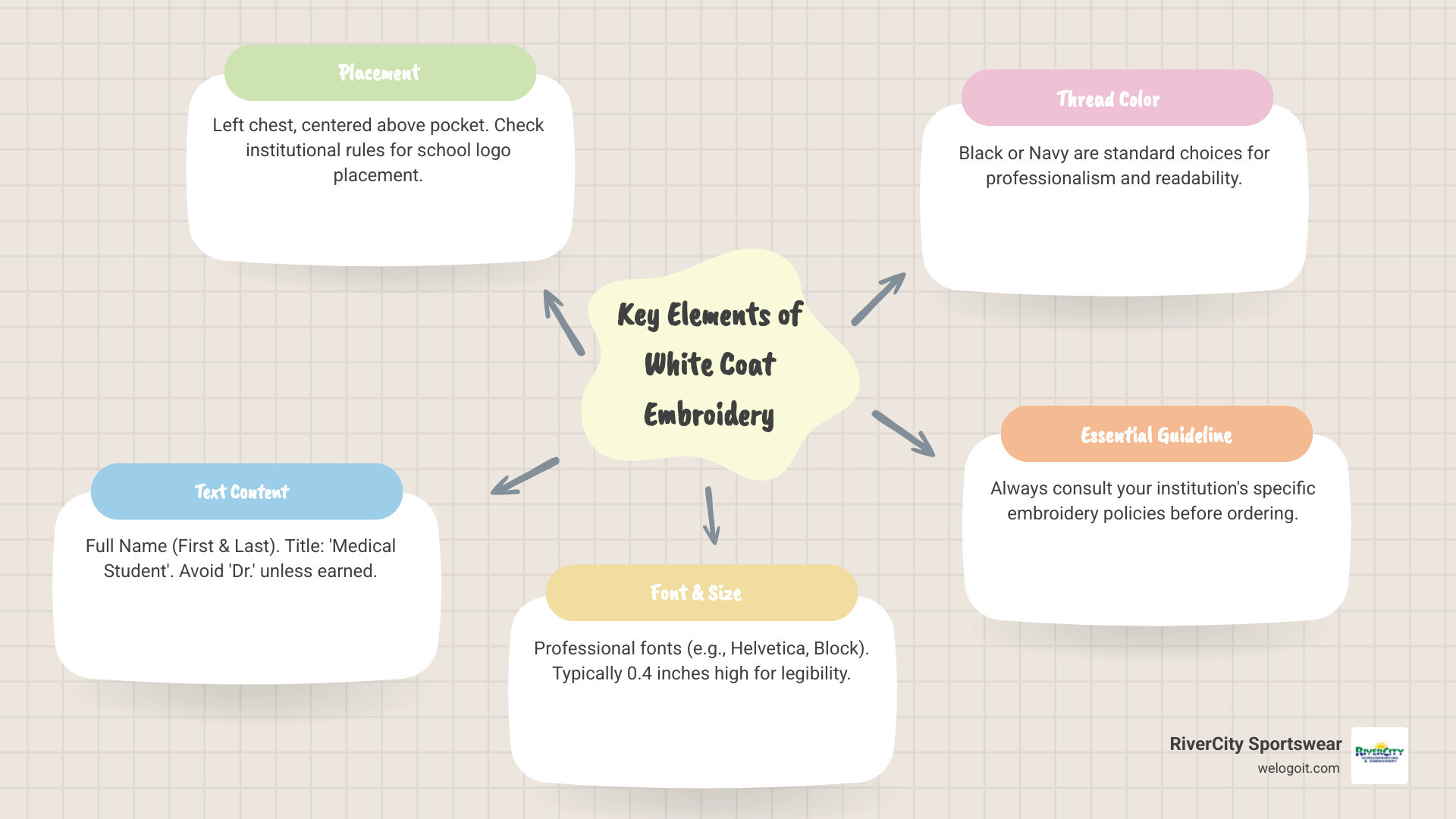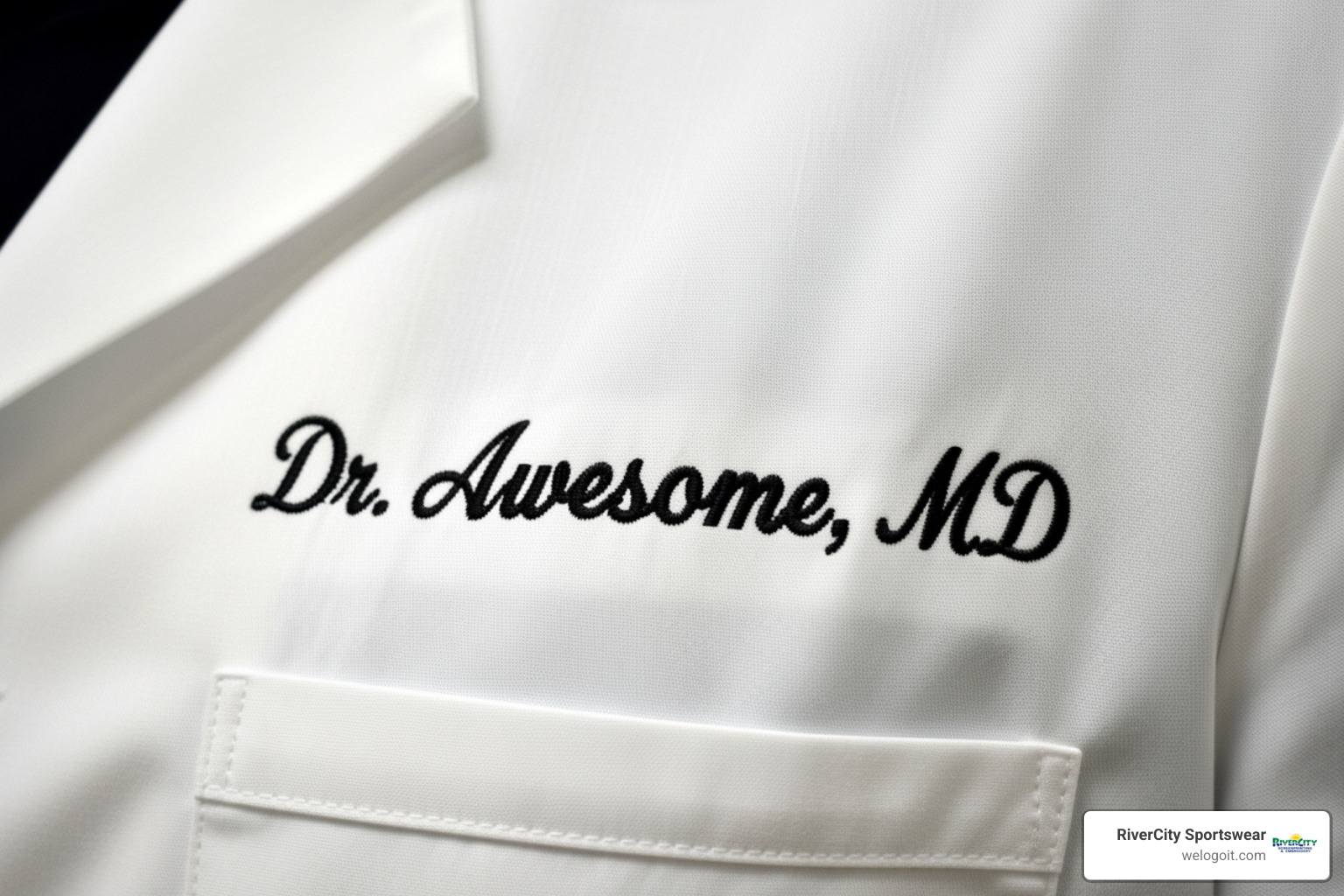
Beyond the Name: What to Embroider on Your Medical Student White Coat
Why Medical Student White Coat Embroidery Matters
Medical student white coat embroidery is more than just a name on fabric—it’s your professional introduction before you even speak. Whether you’re heading to your first clinical rotation, volunteering at a free clinic, or attending the white coat ceremony, that embroidered text helps patients and staff identify you, builds trust, and marks an important milestone in your medical journey.
Quick Guide to White Coat Embroidery:
| What to Include | Best Practice |
|---|---|
| Name | First and last name (or preferred name if you go by your middle name) |
| Title | Check your school’s policy—many prohibit “Dr.” or allow “Medical Student” |
| Font | Helvetica or simple block fonts, typically 0.4 inches high |
| Color | Black or navy thread for professionalism |
| Placement | Left chest, centered above pocket (or as specified by your institution) |
| Timeline | Order 2-3 weeks before you need it |
Most medical schools have specific guidelines about what you can and cannot embroider on your white coat. Some provide coats with the school seal already embroidered and only allow your name on the opposite side. Others are more flexible. The key is to check your institutional rules first—before you pay for embroidery that might violate dress code policies.
The practical benefit is clear: embroidery helps patients and physicians identify you during clinical rotations, preceptorships, and free clinics. It’s a simple way to look professional and make introductions easier in busy healthcare settings, which is why most first-year students get their names embroidered.
I’m Luke Sanders, CEO of RiverCity Screenprinting & Embroidery. For over 15 years, I’ve helped countless medical students and healthcare professionals with medical student white coat embroidery that meets institutional standards. Whether you’re using a school-approved vendor or a local shop, understanding the guidelines ensures your coat represents you well.

Easy medical student white coat embroidery word list:
- embroidered uniforms
- embroidery for jackets
- workwear clothing embroidery
What to Embroider: Crafting Your Professional Identity
Your white coat tells your story before you even introduce yourself. When you’re deciding what to include in your medical student white coat embroidery, you’re making choices that will shape how patients, colleagues, and attending physicians perceive you from day one.
While you want your coat to reflect who you are, the medical field values professionalism and clarity. Following your school’s guidelines is essential. Before ordering embroidery, find your institution’s dress code or personalization policy to avoid issues during clinical rotations.
The same principles that guide custom embroidered business apparel for practicing physicians apply to you as a student: consistency, professionalism, and clear identification.
Your Name: First, Last, and Middle
The gold standard is your full legal first and last name—this matches your ID badge, school records, and official documents.
If you go by your middle name (e.g., “Ellen” instead of “Jane Ellen Doe”), you have options like “Ellen Doe” or “J. Ellen Doe.” According to forum discussions on naming conventions, the consensus is to pick the name you use daily and be consistent with it in your work.
Here’s what matters most: clarity and consistency with your ID badge. Your badge is your primary identification in clinical settings, so your embroidered name should match it as closely as possible.
Avoid using just initials or monograms. While “J.E.D.” might look neat, it doesn’t help patients or staff identify you. Your white coat is a professional tool, not a personalized gift. Full names are always the safest, most professional choice.
Your Title: “Medical Student” vs. “Student Doctor”
This debate comes up constantly, but the answer is straightforward: never embroider “Dr.” on your white coat as a medical student. It’s misleading, violates professional ethics, and can land you in serious trouble with your school.
So what should you use instead? Most institutions prefer “Medical Student” or no title at all. Some allow “Student Doctor,” but this can confuse patients. As noted in a debate on student titles, transparency is key. Your ID badge already clarifies your role; the embroidery is just reinforcement.
The safest approach? Check your school’s policy first. If they allow “Medical Student,” that’s your best bet. If they say no title, stick with just your name. The goal is honest, clear identification that helps patients understand exactly who’s caring for them.
Credentials and Logos
Many medical schools provide white coats with their official seal or logo already embroidered on one side of the chest. This displays your affiliation and helps identify you as part of that institution’s medical community.
If your school allows additional customization, you might consider hospital affiliations or approved departmental logos. However, there’s one critical rule: don’t include credentials from previous degrees unless your institution explicitly permits it and those credentials are relevant to your current role.
For example, adding “RN” from a previous nursing career is generally not allowed on a medical student’s coat, as it can confuse your current role. The same goes for “PhD,” “MS,” or other academic degrees. Your coat should reflect your current role in the healthcare team.
If you want to add a custom logo—say, for a student organization like SNMA or a specific department—you’ll need to go through a process called digitization. This is where your artwork gets converted into a stitch file that embroidery machines can read. As we explain in our guide to embroidery digitizing: what it is and how it works, this one-time process creates a precise map for every stitch.
Most services charge a one-time digitization fee (often around $79) to convert artwork into a stitch file. Once created, the logo can be reproduced perfectly. Always get school approval for custom logos before paying this fee to avoid investing in artwork you can’t use.
The Complete Guide to Medical Student White Coat Embroidery
When you’re thinking about medical student white coat embroidery, it’s easy to focus on just getting your name on the coat. But the quality of the stitching, the placement, and the font choice all add up to create a professional appearance that will serve you well throughout your clinical rotations.
High-quality embroidery is about durability as much as appearance. Your coat will endure long shifts and frequent washing, so professional stitching is crucial to prevent fraying, puckering, and fading. As we’ve found, the key to high-quality stitching lies in professional equipment and attention to detail.
Placement: Where Does the Embroidery Go?
Where you put your embroidery might seem like a minor detail, but it’s one of the most important decisions you’ll make. Get it wrong, and your name could be hidden under a lapel or sitting awkwardly off-center.
The most common placement for your name and title is on the left chest of the white coat, as you’re wearing it. This is typically positioned above the breast pocket if your coat has one. If your school or hospital logo is being added, it usually goes on the right chest, opposite your name. This creates a balanced, symmetrical look that’s standard in healthcare settings.
Your embroidery should be center-justified to keep everything looking neat and professional. One thing many students don’t think about is the lapel, which can cover part of your embroidery when the coat is open. Most people are okay with a few letters being partially covered, but if this bothers you, talk to your embroidery provider. They can adjust the sizing and placement to minimize this issue.
Different institutions sometimes have their own specific requirements. Always check your school’s guidelines before you commit to a placement.
Font, Color, and Size Recommendations
The font, color, and size you choose for your medical student white coat embroidery can make the difference between a coat that looks polished and professional and one that just looks off.

Let’s start with font style. This isn’t the place for fancy scripts or decorative lettering. You need something that’s easy to read, even from across a busy hospital hallway. Helvetica Light is a favorite at many medical schools because it’s clean and modern. Simple block fonts are another solid choice—they’re straightforward and professional. Times New Roman works well too, especially if your institution prefers a more traditional look. The key is legibility. For more on how professional embroidery builds credibility, take a look at our thoughts on embroidery for professional practices.
When it comes to thread color, you really can’t go wrong with black or navy blue. These colors provide excellent contrast against white fabric without being distracting. Some schools specify one or the other, so check your guidelines.
Font height is where a lot of students struggle. A good rule of thumb is around 0.4 inches for font height. This size is readable from a reasonable distance while still looking proportional to the coat. Some institutions specify this exact height in their guidelines.
The goal is simple: your name should be clear, easy to read, and professional. Nothing more, nothing less.
Character and Line Limits for Medical Student White Coat Embroidery
There are practical limits to how much text will fit on your coat’s chest area. Most embroidery services allow for 2 to 3 lines of text. This is usually enough for your name on the first line and a title like “Medical Student” on the second line, if your school allows it.
For each line, you’re typically looking at a maximum of about 25 characters, including spaces. This might sound restrictive, but it’s necessary to keep your embroidery looking clean and professional. If you try to cram too much text into a small area, it becomes hard to read and can look cluttered. Some embroidery vendors even provide character count guides based on the size and style of your lab coat.
The reality is that less is usually more when it comes to white coat embroidery. Focus on the essentials: your name and maybe your title. If you want to learn more about how embroidery design works, our guide on custom apparel embroidery goes into more detail about the technical considerations.
Logistics and Process: From Coat to Clinic
Getting your white coat embroidered might seem like a small task, but it’s one worth planning ahead for. Between coordinating with vendors, understanding turnaround times, and ensuring you meet institutional guidelines, a little preparation goes a long way. The good news? Once you know what to expect, the process is straightforward.
Whether your school coordinates embroidery services or you’re seeking out a local provider like RiverCity Sportswear, understanding the logistics ensures you’ll have your embroidered coat ready when you need it. If you have specific questions or a custom request, we’re here to help with an embroidery request.
Vendors and Embroidery Services
Many medical schools simplify the process by partnering with approved vendors who already know the specific guidelines for font, color, and placement. Some institutions even designate one exclusive vendor and provide their contact information directly to students.
Student organizations can also be a valuable resource. The Student National Medical Association often coordinates white coat embroidery services for members, specifically to help with identification during clinical rotations, preceptorships, and volunteer work at free clinics. These organized services typically streamline the process and ensure consistency.
If your school doesn’t offer a coordinated service, or if you prefer to work with a local embroidery shop, that’s absolutely an option. When choosing a vendor, ask if they can match your school’s guidelines, their turnaround time, costs for custom logo digitization, character limits, and if they can provide samples of past work. A reputable vendor will help you stay compliant with your school’s dress code.
Turnaround Time and Costs
Timing is everything when it comes to embroidery. The typical turnaround time for medical student white coat embroidery is two to three weeks. This is consistent across most vendors, so if you’re ordering for your first rotation or an upcoming white coat ceremony, plan accordingly. This turnaround time gives you plenty of time before your rotations, but don’t wait until the last minute to place your order.
When it comes to costs, a few factors come into play. If you’re adding a custom logo, you’ll encounter a one-time digitization fee. This art fee, typically around $79, covers the process of converting your logo into a stitch file. It’s a one-time investment; once your logo is digitized, it can be reused for future orders without paying the fee again. Our guide on embroidery digitizing: what exactly is it and how does it work? explains this technical process in detail.
The cost for your name and title embroidery is usually charged per line of text. Some vendors offer promotional pricing, while others charge a set fee per line. Forum discussions suggest that embroidered white coats can cost $50 or more total, which typically includes both the coat and the embroidery work. Always request a clear, itemized quote from your vendor before placing your order.
Caring for Your Embroidered Coat
Your white coat will become one of your most-worn garments, so taking care of it—and the embroidery—is important. High-quality embroidery is designed to last, but a few simple care steps will keep your coat looking crisp and professional.
Start by following the care instructions on your coat’s label. Washing in cold water on a gentle cycle is generally your best bet. Harsh detergents and bleach can fade thread colors, so opt for color-safe detergents.
When it comes to drying, high heat is the enemy of embroidery. Over-drying or using high heat settings can cause the embroidery to pucker or shrink. Air drying is ideal, but if you must use a dryer, choose a low heat setting. If your coat needs ironing, turn it inside out and place a cloth over the embroidery to protect the threads from direct heat.
Following these care steps will help maintain the vibrancy of your thread color and prevent puckering, ensuring your medical student white coat embroidery stays professional-looking. For more comprehensive advice, check out our guide on how to keep your embroidered shirts new and intact.
Frequently Asked Questions about White Coat Embroidery
We know that choosing the right embroidery for your white coat comes with a lot of questions. Let’s walk through some of the most common concerns we hear.
Do I have to get my white coat embroidered?
The answer depends on your institution. Embroidery is often optional, not mandatory. Your ID badge is your primary form of identification, so technically, that’s all you need for clinical settings.
That said, there are real benefits to having your coat embroidered. When you’re working at preceptor sites, free clinics, or during clinical rotations, medical student white coat embroidery helps patients and physicians identify you quickly. It’s especially helpful when your ID badge flips around or isn’t immediately visible. This simple addition builds trust and makes communication smoother.
However, we strongly recommend it as an investment in your professional presence. It’s especially helpful for identification at free clinics, preceptorships, and during clinical rotations where clear, quick identification matters.
Can I embroider my coat myself?
We understand the appeal of a DIY project, but we have to be straight with you: embroidering your own white coat is rarely a good idea unless you’re an experienced machine embroidery professional.
Professional embroidery requires specialized commercial machines, specific thread types, and the technical knowledge to digitize designs. As we explain in our overview of embroidery, it’s a craft that blends art with precision technology.
Without the right equipment and expertise, you risk damaging your coat with incorrect needle sizes or tension that can tear the fabric. Home embroidery often results in puckering, solveing threads, or a finish that doesn’t look professional. Your white coat represents years of hard work and deserves a professional touch.
There’s also the practical matter of compliance. Your school likely requires specific fonts, sizes, and placements that are difficult to achieve without professional tools. Save yourself the headache and invest in professional services.
What’s the biggest mistake to avoid with medical student white coat embroidery?
After working with medical professionals for over 15 years, we can tell you that the single biggest mistake is ignoring your institution’s specific guidelines. We’ve seen students spend money on embroidery only to find it violates their school’s dress code. It’s frustrating, expensive, and completely avoidable.

This mistake usually shows up in three ways. First, including unearned credentials is a serious professional misstep. Putting “Dr.” or “MD” on your coat as a student is misleading to patients and colleagues. Your role as a medical student is honorable on its own.
Second, unprofessional fonts or colors can undermine your credibility. Elaborate script fonts or bright colors look more playful than professional. Stick to clear, readable fonts like Helvetica or simple block styles, and professional thread colors like black or navy.
Third, incorrect placement or content can make your coat non-compliant. Your institution may have precise rules about where your name goes, whether you can include a title, and if a school logo is required.
The solution is simple: always check your school’s guidelines before ordering. If anything is unclear, ask your student affairs office or vendor. It’s easier to clarify beforehand than to fix a mistake later. When you’re ready for professional medical student white coat embroidery that meets all standards, we’re here to help.
Conclusion: Wearing Your White Coat with Pride
You’ve made it through medical school’s grueling application process, survived your first anatomy exam, and now you’re standing at the threshold of clinical practice. Your white coat isn’t just another piece of clothing—it’s a symbol of everything you’ve worked for and everything you’re becoming.
The medical student white coat embroidery you choose matters. It’s how patients will identify you when they’re looking for reassurance. It’s how attending physicians will remember your name during rounds. It’s a small detail that carries significant weight in your professional presentation.
As we’ve covered, the details of your embroidery—from name format and title to font and placement—are the building blocks of your professional identity in healthcare. These aren’t arbitrary rules; they are standards of professionalism.
The most important takeaway? Always check your school’s specific white coat policy before ordering embroidery. Every institution has its own guidelines, and following them ensures you’ll never face the awkward situation of needing to re-embroider or replace your coat. A quick email to your student affairs office can save you time, money, and stress.
When you walk into that first clinical rotation wearing your embroidered white coat, you’re joining a long tradition of healers and caregivers. The coat represents your commitment to patients, your dedication to learning, and your respect for the profession. Getting the details right shows you understand the responsibility that comes with it.
At RiverCity Sportswear, we’ve helped countless medical students in Central and South Texas, including San Marcos and Austin, prepare for this milestone. We understand that behind every embroidered name is a future healthcare professional, and we’re committed to providing high-quality work that meets institutional standards and reflects your professionalism.
Your white coat ceremony was just the beginning. Every time you put on that coat with your name carefully stitched on the chest, you’re stepping into your future role as a physician. Wear it with pride. Ready to get started? Explore our professional embroidery services and let us help you create a white coat that represents your best professional self.
Table of Contents
